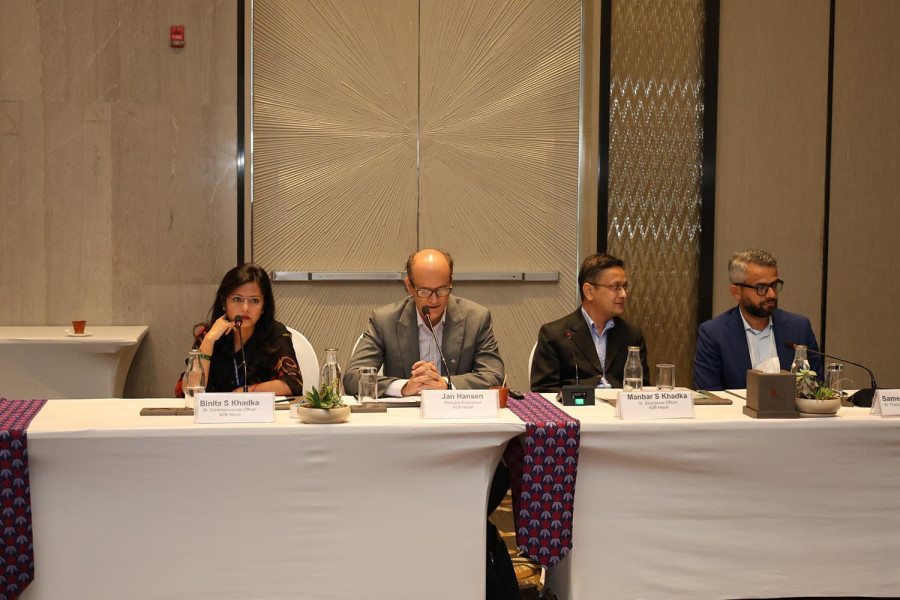Money
Nepal to grow by 3.6 percent in 2023-24, ADB says
The report projects annual average inflation to slide to 6.5 percent in the current fiscal year, ending mid-July, from 7.7 percent in the last fiscal year on subdued oil prices and a decline in inflation in India.
Post Report
Nepal’s economy is anticipated to grow by 3.6 percent in the current fiscal year, up from 1.9 percent growth in the last fiscal year, according to the Asian Development Outlook, released on Thursday.
The projection made by the Asian Development Bank is higher than the World Bank’s estimation of 3.3 percent made a week ago.
"A gradual relaxation of monetary policy coupled with improved consumer and investor confidence is expected to stimulate economic activity in the current fiscal year,” ADB Country Director for Nepal Arnaud Cauchois.
“Moreover, industry is projected to grow more rapidly than in the last fiscal year as capital spending by the government ramps up in the second half of the fiscal year, and as additional hydroelectricity power comes online by the end of this fiscal year.”
Manbar Singh Khadka, Senior Economics Officer at the Asian Development Bank, said that energy would be the key thrust as the country will add 900 MW of electricity to the grid by the end of the fiscal year. “Besides this, low-interest rates would boost the demand for credit, and growing tourism activities will stimulate economic activities.”
According to the Nepal Tourism Board, the country's tourism promotional body, the arrival numbers crossed the million mark in 2023, the first time in four years. This is the third instance that Nepal has received over a million tourists.
“The luxury hotel building spree will create jobs demand,” said Khadka.
He said that construction and manufacturing sectors that have stalled would pick up pace.
The agriculture sector may increase marginally from 2.7 percent in the last fiscal year to 2.8 percent this fiscal year as a record paddy harvest is tempered by a shortfall in winter crops and other agricultural production, given the deficient rainfall this winter.
The report projects annual average inflation to fall to 6.5 percent in 2023-24 from 7.7 percent in 2022-23 on subdued oil prices and a decline in inflation in India, Nepal’s main import source.
The report said that the lingering weakness in domestic demand that continued in the first quarter of this fiscal year will gradually dissipate in the remainder of the fiscal year as government investment outlays accelerate.
Private consumption expenditure will rise as remittance inflow strengthens and prices moderate, while private investment expenditure will expand on monetary easing and financial sector reforms encouraging term loans.
After contracting by 20.2 percent in the last fiscal year and a slow start in the current fiscal year, public investment is expected to expand by 1.5 percent under the 2023-24 budget as development projects are implemented.
Overall fiscal policy will support growth despite the deficit being slated to decline to about 3 percent of the GDP from 6.1 percent in the last fiscal year. The report said that exports would rise on higher electricity exports as Nepal continues to expand its production and transmission infrastructure.
However, merchandise imports, particularly of capital goods, will rise as capital expenditure ramps up, and service imports will rise on higher transport payments and travel costs for Nepalis going abroad.
On balance, net exports will subtract from growth.
The ADB said that external risks remain relatively well contained. The current account deficit may fall again into deficit after registering a surplus in the first half of 2023-24.
As the trade deficit contracted by 4.7 percent year-on-year in the first half of the current fiscal year, and as workers’ remittances expanded by 22.6 percent year-on-year, the current account recorded a surplus of $1.2 billion.
However, amid higher imports and stable remittance inflows in the remainder of the fiscal year, the 2023-24 current account deficit is forecast at 0.7 percent of the GDP.
“Downside risks to the economic outlook in 2023-24 may arise from a downturn in the global economy affecting Nepal’s tourism and remittance receipts,” said ADB Principal Economist for Nepal Jan Hansen.
Any intensified geopolitical turmoil could disrupt supply chains, pushing up global inflation and tightening global financial conditions. This may lead to a tightening of domestic monetary policy, undermining investment and consumption, and dragging down growth.
A downturn in the global economy would affect Nepal’s tourism and remittance receipts, the bank said.
Delays in the implementation of public projects could weigh heavily on growth as well. As Nepal is always at high risk from natural hazards, catastrophes can substantially reduce economic growth, according to the report.




 6.12°C Kathmandu
6.12°C Kathmandu













